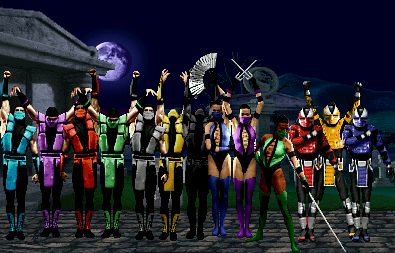

Both setups have their strengths and weaknesses, and neither is completely ideal, but they are both competent enough to get the job done. This scheme changes all the special moves and fatalities into simple combinations of the special button and joystick directions. The second “easy” control setup features only 5 buttons – punch, kick, block, run, and special. This is my preferred way to play because it’s what I know, but it also makes it difficult to pull of moves that require multiple buttons to be held down at the same time, like Sub-Zero’s slide for example. The first “pro” control scheme has all 6 buttons of the original arcade game, and all the moves are performed just like in the original. The joystick remains fixed, but it’s in a pretty good default position anyway. It offers two control schemes and the ability to move the buttons for each wherever you want on the screen. Here is where Ultimate Mortal Kombat 3 slips up the most.

Regardless of your feelings about the graphics, none of it would matter anyway if the game didn’t control well. Some of these look better in 3D, and some I would prefer the original, but either way it’s still hugely satisfying to pull off a finishing move on a defeated opponent, and that’s what’s important. On that note, all of the fatalities, babalities, friendships, and animalities are included for each of the characters. There’s really nothing like knocking someone in front of a subway train or into a pit of spikes in 3D. Again there is only a selection of 10 stages from the original arcade game’s 16 or so, but the ones chosen here are the best of the bunch and contain all of the levels with stage fatalities. The best part about the game being in 3D is that the redone backgrounds look downright gorgeous. Hopefully they take a page out of Street Fighter IV‘s playbook and offer frequent updates with new characters, because as it is now the roster feels lacking. Ultimate Mortal Kombat 3 in the arcades boasted a healthy roster of 22+ fighters, whereas the iOS version only has a selection of 11 including two unlockable characters, and I believe the two bosses are playable though I have yet to verify that myself. One huge disappointment though is the lack of available characters. Because of these points, I understand and accept the decision to go 3D. I can’t imagine the old digitized sprites looking especially great on iOS screens, and the many frames needed to animate them would likely cause performance issues. The characters are comprised of fairly basic 3D models but they look like their originals for the most part, and this also allows them to appear extra crisp, especially on the Retina Display. Purists will likely cry foul at this design choice, but I have a more positive feeling towards it.

The biggest change is that the game is completely rendered in 3D. The most significant thing to notice about Ultimate Mortal Kombat 3 is that despite its name this is in no way a direct port of the arcade game. It gets a lot of things right, and even does some interesting new things, but some of the changes will alienate longtime fans who are looking for a trip down nostalgia road, and the poor execution of the controls can make the game difficult to enjoy. And Ultimate Mortal Kombat 3 for iOS is far from terrible, and in fact it’s pretty good. I even bought and suffered through the abomination that is Mortal Kombat Advance on the GBA, so I can definitely recognize a terrible MK game when I see it. I’ve since owned just about every version of every Mortal Kombat game for every console over the years. I’m a diehard Mortal Kombat fan, going back to the very first release in arcades almost two decades ago. And just like that, yesterday Ultimate Mortal Kombat 3 was released in the App Store. Just a few days ago, it was confirmed that indeed an iOS version of Ultimate Mortal Kombat 3 was in the works from the folks at EA Mobile. Given the incredible success of Street Fighter IV since its release on the App Store, I’ve always wondered if its 90s arcade competitor Mortal Kombat would ever grace our touch screens.


 0 kommentar(er)
0 kommentar(er)
